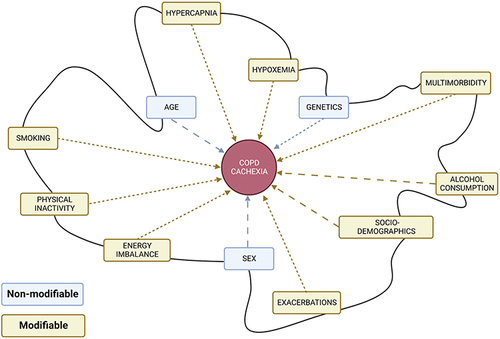Figures & data
Figure 1 Graphical overview of published criteria to diagnose cachexia in patients with COPD. Given the variability in the definition of cachexia, it is important to note that this review covers a wide spectrum of patients and is not limited to a single definition of COPD cachexia. For specific diagnostic criteria and cut off values, the authors refer to the publications from Evans (2008), Muscaritoli (2010), Schols (2014) and McDonald (2019). Pre-cachexia criteria = light; Cachexia criteria = dark. *In cases where weight loss cannot be documented, a body mass index (BMI) <20 kg/m2 is sufficient. Based on Evans (2008), fatigue is interpreted as physical and/or mental weariness resulting from exertion and an inability to continue exercise at the same intensity with a resultant deterioration in performance. Based on Evans (2008) and Muscaritoli (2010), anorexia or anorexia-related symptoms are interpreted as limited food intake or poor appetite. Based on Evans (2008) and Muscaritoli (2010), abnormal histochemistry is interpreted as increased inflammatory markers, though anemia or low serum albumin may also be present. Created with BioRender.com.

Figure 2 Conceptual framework of etiological factors involved in COPD cachexia. The complex interplay of these factors is depicted via the irregularly shaped black line that links all factors to each other. It illustrates that each factor possibly influences other factors. For every patient with COPD cachexia, the factors involved and their interplay (and consequently the shape of the black line) will be different. Wider space between dashed line = scientific evidence is not consistent or not currently available in patients with COPD. Created with BioRender.com.

Box 1 Ways to Minimize Modifiable Etiological Factors
Box 2 Multimodal Interventions for Cachexia in COPD
